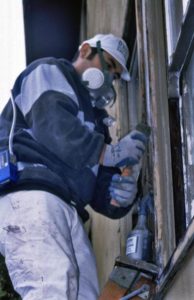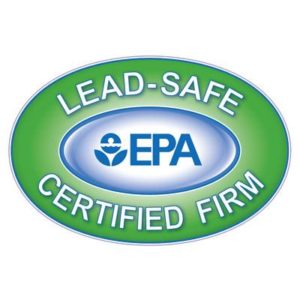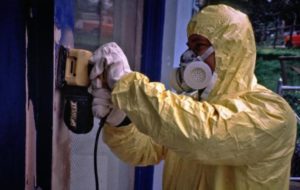 EPA’s Lead Safe Certification
EPA’s Lead Safe Certification
EPA’s Renovation, Repair, and Painting (RRP) rule requires any contractor, including renovators, electricians, HVAC specialists, plumbers, painters, and maintenance staff, that disturb painted surfaces in homes, child care facilities, and pre-schools built before 1978 be certified and follow lead-safe work practices. Becoming certified can help your firm:
- Avoid fines and civil liability;
- Protect your workers, yourself, and your customers from a health risk; and
- Gain a competitive advantage.
Learn how to become certified. RRP rules vary slightly by state, so check with your state for more specific regulations.
EPA’s Lead Abatement Worker and Supervisor Certification
Under EPA’s Lead-based Paint Activities Program and in states or tribes that have taken over authority, accredited training providers may offer training required to become certified as a lead abatement worker, inspector, risk assessor, supervisor, or project designer.
This page contains information about the model training course the New England Lead Coordinating Committee developed to provide instruction to individuals seeking lead abatement worker and supervisor certification. This model course is provided for informational purposes to show training providers the required curriculum and can only be used, with prior authorization, by a currently accredited training provider. Training providers must offer courses that are consistent with the abatement regulations in their state. For the worker or supervisor discipline, the training provider may use the model training course materials as is, or may customize the materials for their particular needs. Please note the Authorizing Agency for your state must first approve all your course materials prior to certification in accordance with their regulations.
This material is intended to be general enough that it provides the base to cover the requirements of EPA’s Lead-based Paint Activities Program. Each state that has taken over authority from EPA to administer the Lead-based Paint activities has their own set of statutes and regulations with EPA’s program as the framework. However, each state is different and in some cases may have more stringent requirements than those of EPA. The states of Connecticut, Maine, Massachusetts, New Hampshire, Rhode Island, and Vermont have provided additional PowerPoints to cover the rules and regulations especially where they differ or are more stringent than the national model.
The Model Worker and Supervisor Course: Residential Lead-Based Paint Abatement consists of the instructor manual (in PDF format), the student manual (in PDF format), and the presentation slides (in PowerPoint format). There are nine chapters for the worker course, an additional three chapters for the supervisor course. Also included are PowerPoints covering hands-on training options and slides covering each state’s rules and regulations.
Download the Model Worker and Supervisor Course files:
Student Manual – Worker & Supervisor Course
Instructor Manual – Worker & Supervisor Course
PowerPoints Introduction & Chapters 1-4
PowerPoints Chapters 5-8
PowerPoints Chapters 9-12
Hands-On Materials & Activities PowerPoint Slides
State Specific PowerPoint Slides
Additional links that will be helpful during the course are included below: Legislation, Regulations and Policy
The following are legislation, regulations and policy for EPA’s Lead-based Paint Activities Program.
- 40 CFR Part 745 Lead-Based Paint Poisoning Prevention in Certain Residential Structures
- Information about quality control (QC) plans are described in 40 CFR § 745.225(c)(9)
- Identify the proportion of course test questions in a course test blueprint which should be devoted to each topic using:
- 745.225(d) for an initial course test blueprint, and
- 745.225(e)(1) for a refresher course test blueprint.
- Read the Residential Lead-Based Paint Hazard Reduction Act of 1992 legislation that provides EPA authority for the Agency’s lead-based paint training and certification programs.
Industry Regulations
 The Occupational Safety and Health Administration (OSHA) General Industry Lead Standard (1910.1025) requires employers to do a number of things to make sure that the workplace is safe and covers most industries, but not construction. The OSHA Lead in Construction Standard (1926.62) applies to all construction work where an employee may be exposed to lead on the job. All work related to construction, alteration, or repair – including painting and decorating – is included. Learn more about employers’ responsibilities and how to protect your employees.
The Occupational Safety and Health Administration (OSHA) General Industry Lead Standard (1910.1025) requires employers to do a number of things to make sure that the workplace is safe and covers most industries, but not construction. The OSHA Lead in Construction Standard (1926.62) applies to all construction work where an employee may be exposed to lead on the job. All work related to construction, alteration, or repair – including painting and decorating – is included. Learn more about employers’ responsibilities and how to protect your employees.
Protect Yourself and Your Workers
According to OSHA, the most effective way to protect your workers is to minimize their lead exposure through:
- Engineering controls, including exhaust ventilation, enclosure or encapsulation, substitution, component replacement, process or equipment modification, and isolation;
- Housekeeping and personal hygiene, including provision of change areas, showers and washing facilities, and end-of-day procedures;
- Use of personal protective clothing and equipment, including respiratory protection; and
- Provision of information and training to employees.
 Resources for Contractors/Lead Professionals
Resources for Contractors/Lead Professionals
- Non-certified worker training (NELCC): This training program was developed for certified renovators to use in training other renovation workers who, under the U.S. Environmental Protection Agency’s Lead: Renovation, Repair, and Painting Program, must be trained but are not required to be certified.
- Find an RRP Trainer in your area
- Find an RRP-certified firm in your area
- For state-specific information, check out the resources below:
- Connecticut’s Lead Poisoning Prevention and Control Program
- Maine’s Lead Hazard Prevention Program
- Massachusetts’ Department of Labor Standards
- New Hampshire’s Healthy Homes and Lead Poisoning Prevention Program
- Rhode Island’s Lead Poisoning Information
- Vermont’s Lead Information for Contractors

